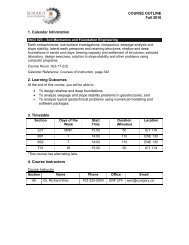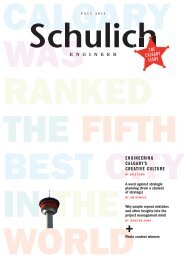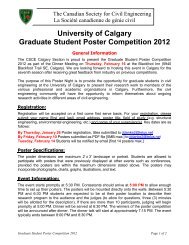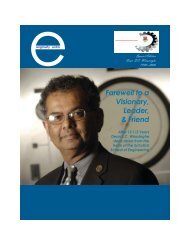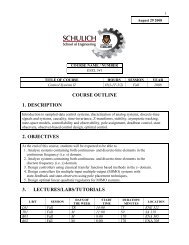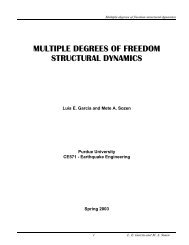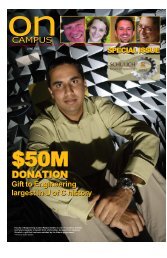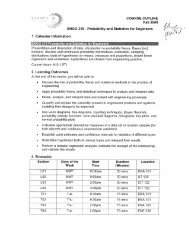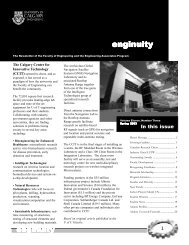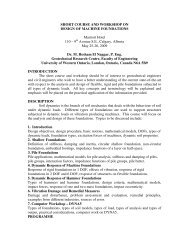Enginuity Winter 2005 - The Schulich School of Engineering ...
Enginuity Winter 2005 - The Schulich School of Engineering ...
Enginuity Winter 2005 - The Schulich School of Engineering ...
You also want an ePaper? Increase the reach of your titles
YUMPU automatically turns print PDFs into web optimized ePapers that Google loves.
Getting into the Rhythm<br />
PhD student Dijana Popovic is developing algorhythms to aid in<br />
breast cancer detection.<br />
Making Waves<br />
Dijana Popovic, currently in her 3rd year <strong>of</strong> PhD studies, is<br />
the <strong>2005</strong> recipient <strong>of</strong> the Izaak Walton Killam Memorial<br />
Scholarship. <strong>The</strong> award will go a long way in helping Dijana<br />
with her research into Breast Cancer Detection.<br />
Popovic is developing algorithms that will increase the<br />
accuracy and the specificity <strong>of</strong> the Tissue Sensing Adaptive<br />
Radar (TSAR) system for microwave detection <strong>of</strong> early<br />
breast tumours. <strong>The</strong> system is being developed by an<br />
electromagnetics group in the Department <strong>of</strong> Electrical<br />
and Computer <strong>Engineering</strong>, run by Drs. Michal Okoniewski<br />
and Elise Fear.<br />
TSAR operation is based on the significant contrast in<br />
electrical properties that exists between the normal and<br />
diseased breast tissue. A number <strong>of</strong> antennas are scanned<br />
around the breast to produce an image and localize the<br />
tumours, if present. In comparison to X-ray mammography,<br />
the TSAR system does not involve compression <strong>of</strong> the breast<br />
and exposure to ionizing radiation, while providing better<br />
accuracy due to the high electrical contrast between<br />
tissues.<br />
<strong>The</strong> process appears to have the potential to detect very<br />
small tumors. It is expected that the TSAR equipment will be<br />
significantly less expensive than some alternatives, such as<br />
MRI and nuclear medicine methods; and safety is also a<br />
benefit since the power <strong>of</strong> the radar pulses used in imaging<br />
are less than those generated by cell phones.<br />
Around the SSE Cont’d.<br />
Popovic was also awarded the Killam -<br />
Donald N. Byers Prize for submitting the best<br />
statement <strong>of</strong> program <strong>of</strong> studies and research.<br />
Big Thinking on Small<br />
Scale Solutions<br />
CMC Microsystems held their Annual<br />
Symposium on Thursday, October 13 th in<br />
Ottawa to explore the opportunities and<br />
challenges presented by microsystems<br />
integration. This year, <strong>Schulich</strong> <strong>School</strong> <strong>of</strong><br />
<strong>Engineering</strong> graduate students Lee Hartley and<br />
Holly Pekau each took home awards in<br />
different categories. Four awards were given<br />
out from forty-one entries from across Canada.<br />
Lee Hartley, supervised by Dr. Karen Kaler, took<br />
home the newly added Integration Award for<br />
his presentation on ‘Active pixel sensing &<br />
glass micr<strong>of</strong>luidics via flip-chip-on-glass hybrid<br />
integration’. This research could lead to<br />
disease diagnosis via computer chips. <strong>The</strong><br />
award recognizes the demonstration <strong>of</strong> the<br />
most effective multi-technology and/or multidisciplinary<br />
Microsystems project.<br />
Also taking home an award was Holly Pekau,<br />
supervised by Dr. James Haslett, for her<br />
presentation <strong>of</strong> a novel sub-sampling RF front<br />
end for next generation wireless digital radio.<br />
<strong>The</strong> DALSA Corporation Award recognizes<br />
novel use <strong>of</strong> microelectronic components or<br />
microsystems.<br />
Imed Zine El-Abidine, supervised by Dr. Michal<br />
Okoniewski, received an honourable mention<br />
for his presentation.<br />
<strong>The</strong> awards are intended to be used to further<br />
the winner’s education or training related to<br />
microsystems.<br />
<strong>The</strong> Izaak Walton Killam Memorial Scholarships are open<br />
for competition among Ph.D. students , with approximately<br />
nine awards made annually to the top ranking students.<br />
<strong>The</strong> award is valued at $25,000 per annum and includes a<br />
$3000 research allowance. <strong>The</strong> award has the potential for<br />
a second year <strong>of</strong> funding and will certainly benefit Popovic.<br />
“I don’t have to worry about money for living expenses,”<br />
says Popovic <strong>of</strong> the finanacial benefits <strong>of</strong> the award. “<strong>The</strong><br />
research money will also be extremely useful for purchasing<br />
computer hardware.”<br />
SCHULICH SCHOOL OF ENGINEERING<br />
9



